Betelgeuse's dimming — a variation seen even with the naked eye — led Miguel Montargès and his team to point out the Very Large Telescope (VLT) from the ESO (Southern European Observatory) towards this star at the end of 2019.
An image from December 2019, when compared to a previous image of the star taken in January of the same year.o, showed that the stellar surface was significantly darker, especially in the southern region. However, astronomers didn't know why.
The team continued to observe the star during its “Great Dim Brightness”, capturing two new images, one in January 2020 and another in March 2020. By April 2020, Betelgeuse had already returned to its normal glow.
“For once in a lifetime, we've seen the variation of a star in real time, on a scale of weeks,” said Montargès, of the Observatoire de Paris, France, and KU Leuven, Belgium. At images now published they are the only ones we have that show the Betelgeuse surface to vary in brightness over time.
In the new study, published in the journal Nature, the team revealed that the mysterious decrease in brightness was caused by a veil of dust that covered the star, which, in turn, resulted in a drop in temperature on the stellar surface.
Betelgeuse's surface varies regularly as gas bubbles move, shrink and enlarge within the star. The team concluded that sometime before the Great Dim Brightness, the star ejected a huge bubble of gas that moved away. When a part of the surface cooled a short time later, this temperature decrease was enough to allow the condensation of this gas in solid dust.
“We are directly watching the formation of so-called stardust,” said Montargès, whose study showed that dust formation can occur very quickly and close to the surface of a star. “Dust ejected from cold evolved stars, such as the ejection we saw, can become the building blocks of terrestrial planets and life,” adds Emily Cannon of KU Leuven, who was also involved in the study.
Rather than just being the result of a dust ejection, there was a lot of speculation online that Betelgeuse's dimming might be a sign of its imminent demise in the form of a supernova explosion.
Since the XNUMXth century, there hasn't been a supernova explosion in our Galaxy, so today's astronomers don't know exactly what to expect from a star in the phase that precedes this explosive event. However, this new research work confirmed that Betelgeuse's Great Dimming of Brightness was not due to any signs indicating that the star was about to explode.
Watching this darkening of a well-known star was exhilarating for both professional and amateur astronomers, as Cannon summarizes: “Looking at the stars in the night sky, it seems to us that these tiny, sparkling points of light are eternal. Betelgeuse's dimming shattered that illusion”.
The team used the instrument Sphere (Spectro-Polarimetric High-contrast Exoplanet REsearch) mounted on the ESO VLT to directly image the Betelgeuse surface along with data collected by the instrument GRAVITY mounted on Interferometer of Very Large Telescope (VLTI) to monitor the star as it decreases in brightness.
The telescopes, located in the Paranal Observatory from ESO in the Chilean Atacama Desert, were “vital diagnostic tools in discovering the cause of this darkening,” Cannon said. “We were able to observe the star not just as a point, but with enough resolution to be able to distinguish details on its surface and monitor it throughout the entire event,” adds Montargès.
Montargès and Cannon look forward to what the future of astronomy will bring to the study of the red supergiant Betelgeuse, in particular with the advent of Extremely Large Telescope of the ESO (ELT).
“With an ability to achieve unprecedented spatial resolutions, the ELT will allow us to obtain direct images of Betelgeuse in remarkable detail,” said Cannon. "The telescope will also significantly expand the sample of red supergiants for which we can resolve the surface through direct imaging, thus helping us to unravel the mysteries that lie behind the winds of these massive stars."





















Comments